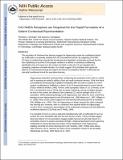| dc.contributor.author | McHugh, Thomas J. | |
| dc.contributor.author | Tonegawa, Susumu | |
| dc.date.accessioned | 2012-11-15T17:45:15Z | |
| dc.date.available | 2012-11-15T17:45:15Z | |
| dc.date.issued | 2009-07 | |
| dc.date.submitted | 2009-06 | |
| dc.identifier.issn | 1050-9631 | |
| dc.identifier.issn | 1098-1063 | |
| dc.identifier.uri | http://hdl.handle.net/1721.1/74649 | |
| dc.description.abstract | The acquisition of Pavlovian fear learning engages the hippocampus when the conditioned stimuli are multimodal or temporally isolated from the unconditioned stimuli. By subjecting CA3-NR1 KO mice to conditioning protocols that incorporate time-dependent components, we found that the loss of plasticity at recurrent CA3 synapses resulted in a deficits in contextual conditioning specifically when the exposure to the context was brief or when the unconditioned stimulus was signaled with a competing, predictive unimodal stimulus. Our results suggest CA3 contributes both speed and salience to contextual processing and support the theory of competition between multimodal and unimodal conditioned stimuli for associative learning. | en_US |
| dc.language.iso | en_US | |
| dc.publisher | Wiley Blackwell | en_US |
| dc.relation.isversionof | http://dx.doi.org/10.1002/hipo.20684 | en_US |
| dc.rights | Creative Commons Attribution-Noncommercial-Share Alike 3.0 | en_US |
| dc.rights.uri | http://creativecommons.org/licenses/by-nc-sa/3.0/ | en_US |
| dc.source | PMC | en_US |
| dc.title | CA3 NMDA Receptors are Required for the Rapid Formation of a Salient Contextual Representation | en_US |
| dc.type | Article | en_US |
| dc.identifier.citation | McHugh, Thomas J., and Susumu Tonegawa. “CA3 NMDA Receptors Are Required for the Rapid Formation of a Salient Contextual Representation.” Hippocampus 19.12 (2009): 1153–1158. | en_US |
| dc.contributor.department | Massachusetts Institute of Technology. Department of Biology | en_US |
| dc.contributor.department | Massachusetts Institute of Technology. Department of Brain and Cognitive Sciences | en_US |
| dc.contributor.department | Picower Institute for Learning and Memory | en_US |
| dc.contributor.department | RIKEN-MIT Center for Neural Circuit Genetics | en_US |
| dc.contributor.mitauthor | Tonegawa, Susumu | |
| dc.contributor.mitauthor | McHugh, Thomas J. | |
| dc.relation.journal | Hippocampus | en_US |
| dc.eprint.version | Author's final manuscript | en_US |
| dc.type.uri | http://purl.org/eprint/type/JournalArticle | en_US |
| eprint.status | http://purl.org/eprint/status/PeerReviewed | en_US |
| dspace.orderedauthors | McHugh, Thomas J.; Tonegawa, Susumu | en |
| dc.identifier.orcid | https://orcid.org/0000-0003-2839-8228 | |
| mit.license | OPEN_ACCESS_POLICY | en_US |
| mit.metadata.status | Complete | |
